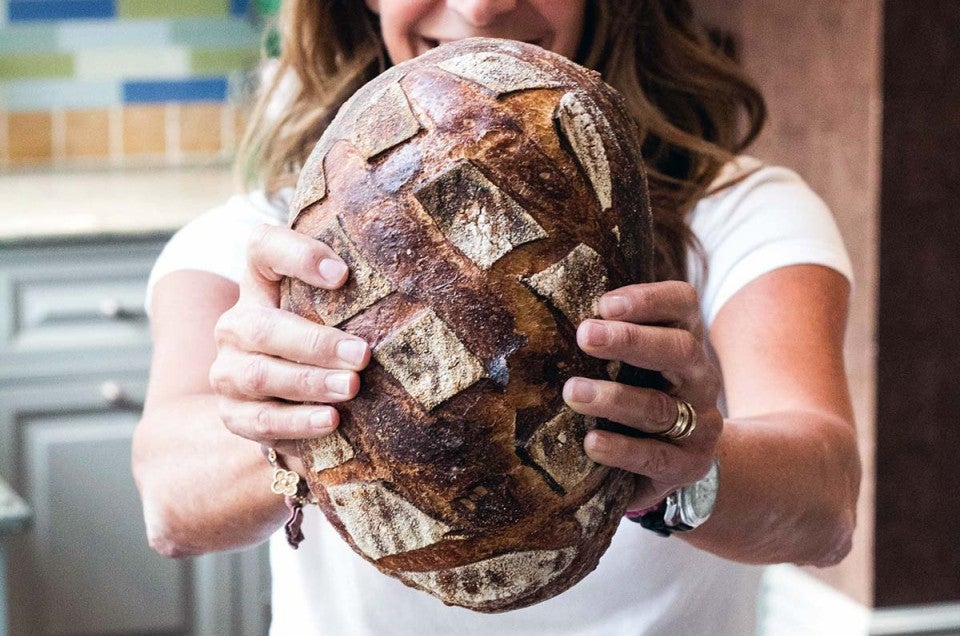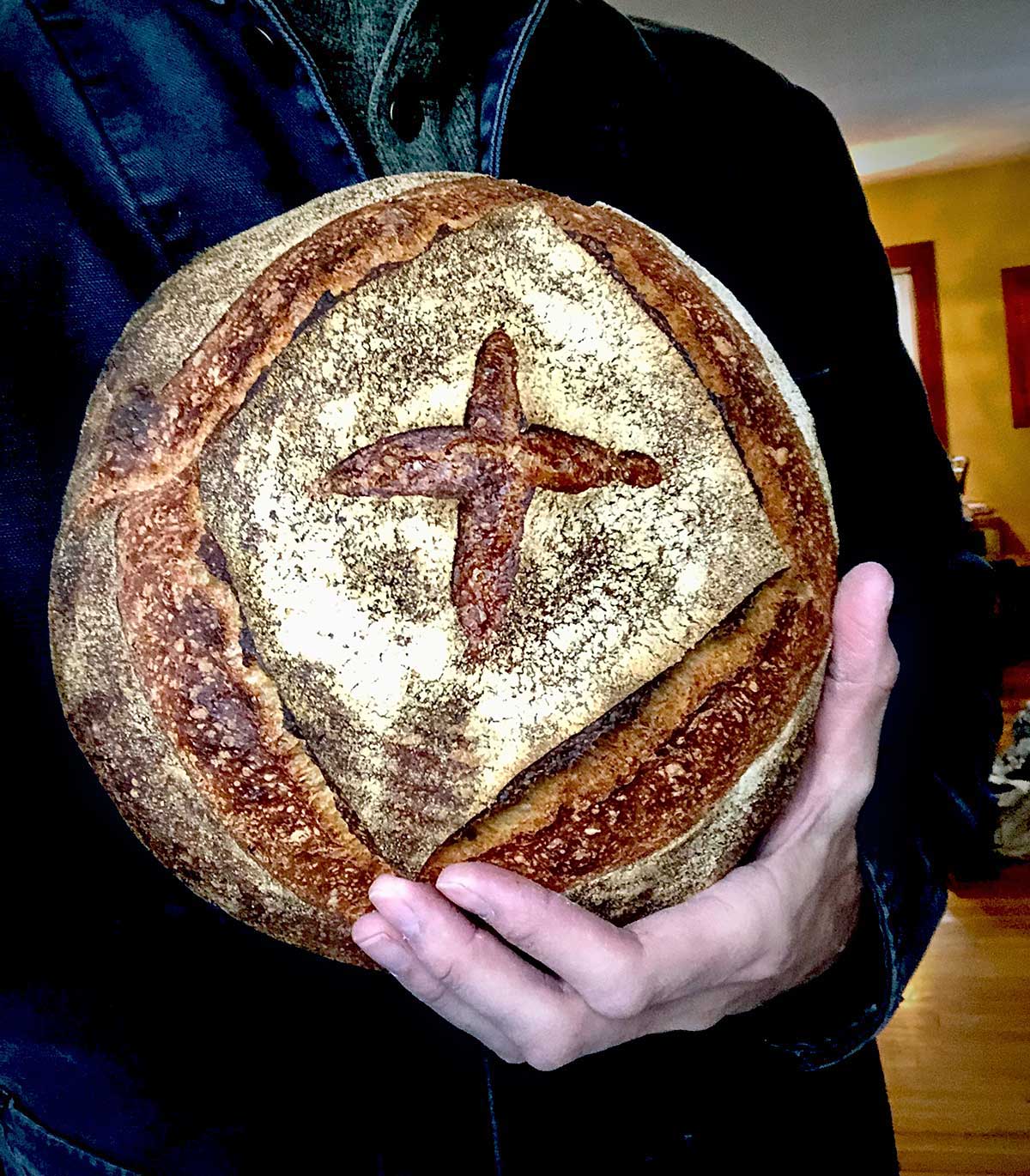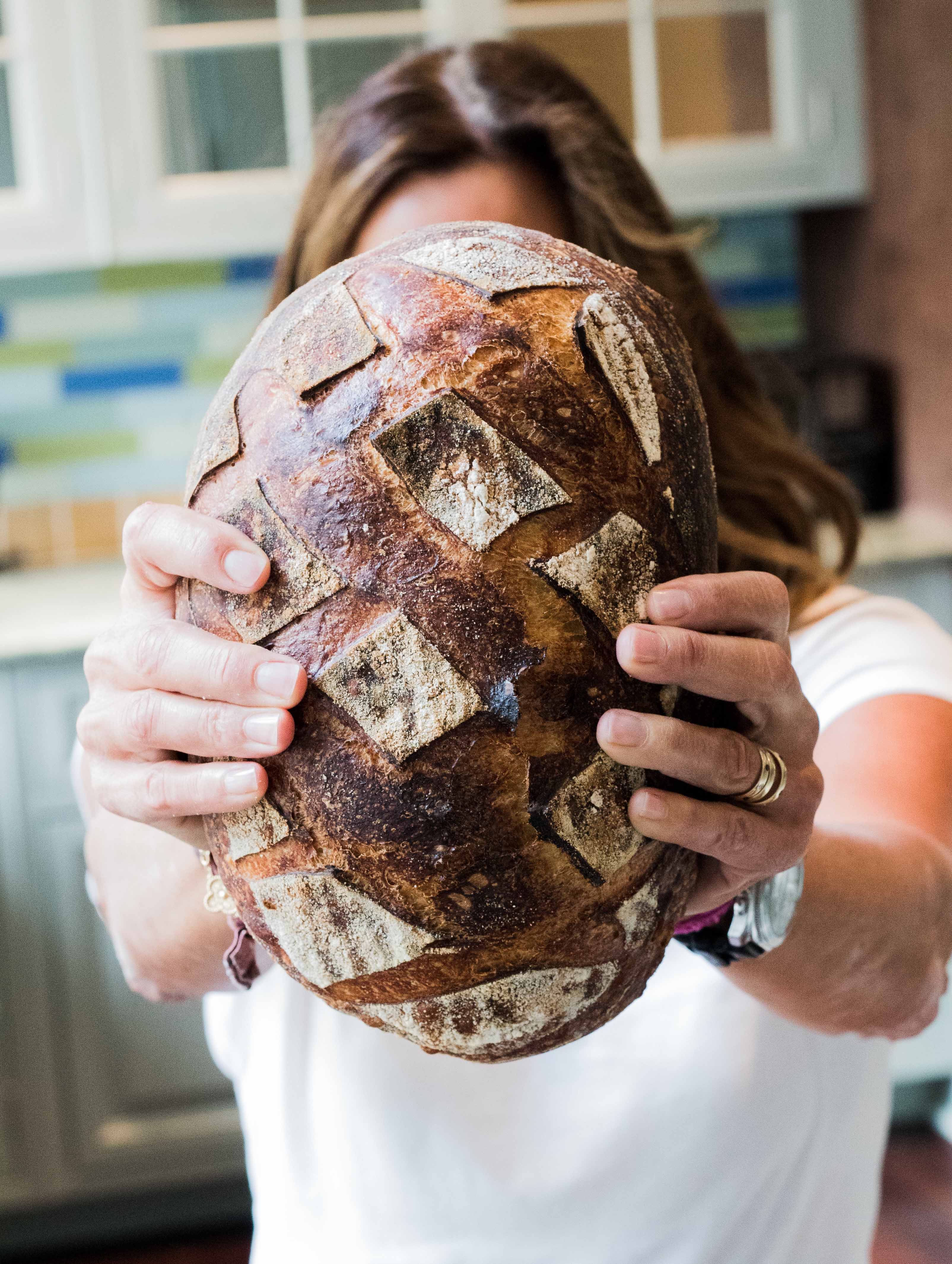


Bakers are friendly people. So friendly, in fact, that they ping my phone at all hours. Sometimes it’s a question (Hey! Where can I get those proofing baskets!?) or a picture of a great bake (Check this out!!! Jealous?) or a request for a recipe (Send me that Rye Pretzel pls). The conversation is open — you don’t need an intro — just let the random texts fly!
Recently, one of these exchanges changed the way that I make bread at home.
Maura: I’m not using preferments. I just use starter from the fridge ...
Me: No preferment??!
Maura: Nope
Me: How much bulk fermentation?
Maura: 12 hours ... it works ...
Me: ???? Send me a picture
Maura Brickman, a serious home baker in Connecticut, followed up her text with a picture of a large crusty loaf with gorgeous color. It was bakery quality by anyone’s standard — and she made it with "unrefreshed starter," straight from the refrigerator.

As a baker, convention has been my path to reliable results. I trust what I have done before — I know how to produce reliable results.
Maura doesn't care about convention. Free of “should” and “ought to,” she bends her breadmaking process to fit her busy schedule. She doesn’t take any guff from her starter or loaves — she's the boss of her bread.
After some thought about her method and convinced that there must be a flaw, I decided to give the Boss’ method a shot.
Before I outline her process, let me quickly clarify standard procedure: the way things normally go.
Sourdough bread traditionally begins with a preferment — a dough set for 12 to 18 hours to develop flavor — followed by mixing and bulk fermentation. After bulk, we divide, shape, proof (either at room temperature or chilled until the next day), and bake.
Maura alters this process to fit her day. Remember: She’s the boss! Rather than setting a preferment, she skips directly to the final mix, using a small amount of starter that she feeds once a week and keeps in the refrigerator to leaven her sourdough bread. After the mix, her dough rises for approximately 12 hours before the divide and shape.

If you've read the piece that I wrote about preferments and flavor, you’ll know that I think they're the difference between run of the mill and a loaf you’ll remember. In this method, which skips the preferment, flavor comes from the long bulk fermentation. We’ve got flavor covered — just in an unorthodox way.
But why not just go with the normal process? Here’s the answer.
Have you ever been a bread hostage? Did you ever feel like, “I’d love to make bread but I don’t have a half day to do so.” Or, “I’d love to attend your wedding, but I might be making bread that day.” At my house, there's quite a bit of coming and going. While I enjoy the opportunity to slow down and make beautiful things, there are also days where I just need to put great sourdough bread on the table.
As a professional baker, the needy schedule of bread and pastry can rule my day. But when I’m on my own time, it can be a challenge to fit everything in. Does this ring a bell?
Maura’s system offers several points of relief. First, it allows me to limit my dough interactions to the beginning or end of the day (no more “take your dough to work” scenarios).
Second, I don’t have to plan too far ahead if I want to mix up a dough (remember, no preferment, just grab some starter and go).
And last, there's no discard. I can thumb past all the delicious recipes for discarded starter, which (although amazing!) I may or may not have time to try.
Here’s Maura's process.

Maura usually starts after dinner, around 8 p.m. Like many serious bread bakers, she measures her ingredients exclusively by weight, so I’m going to do the same in this article. She also tracks the temperature of her ingredients. In this case, all dry ingredients should be room temperature, 70 to 72°F.
In a 6-quart container, combine the following:
900g King Arthur Unbleached Bread Flour
100g King Arthur Whole Wheat or Golden Whole Whole Wheat
800g tepid water (75°F to 80°F )
20g salt
40g sourdough starter, unfed/discard
Use starter straight from the fridge, though it’s best if fed within the past week.
Mix the ingredients by hand until the dough forms a shaggy mass and the flour is hydrated.
Set a 15-minute timer and leave the dough in the container at room temperature with the lid on.

At 15 minutes, return to the container and fold by pulling the sides of the dough up with a wet hand, then pressing to the middle to seal. Repeat this on all four sides, then set the timer again for 15 minutes.
Wait and fold the dough two more times. As you perform the folds you’ll notice that the dough smooths out, gaining strength and becoming elastic (more like a rubber band).
Leave the dough covered tightly at room temperature (approximately 72°F) overnight (about 12 hours). If using a mixing bowl, place the bowl in a plastic bag. If using a 6-quart container, just put the lid on — the main point here is that the dough should be well-covered to keep the exposed surface moist.

At 8 a.m. the next day (don’t be too uptight here — it could be 7 a.m. or 9 a.m.), divide the dough into two pieces. Gently form them into rounds, seam-side down, and rest for 10 minutes, covered.
Generously and evenly dust two lined bannetons with whole wheat flour.

Shape the loaves into boules or batards. If your dough doubled on the overnight rise (the marked 6-quart container will help with judging this), put the loaves straight into the refrigerator. If it's risen by just 50%, leave the loaves out for a bit (30 to 60 minutes) and then put them in the fridge. Note that the loaves should be covered with a shower cap or plastic bag.
Maura’s baking schedule (which is essentially a daily habit — no wonder she’s so good at it!) aligns well with her generous nature. Some days she bakes in the morning and distributes loaves to friends or neighbors. When her kids are home from college, she adjusts; they can easily polish off a loaf with dinner.
To bake, preheat two Dutch ovens — approximately 4-quart size — in a 500°F oven for 45 minutes. (Make sure your Dutch ovens are tough enough to be preheated empty; not all are. Check the manufacturer's literature.)
Invert the risen loaves onto a sheet of parchment, score with a lame, and carefully place the dough in the preheated Dutch ovens. Replace the lids and return to the oven.

Reduce the oven temperature to 450°F and bake for 20 minutes with the lids in place.
After 20 minutes, remove the lids and bake for another 20 to 25 minutes, or until the loaves have deep color.
After a few months of making Maura’s bread and receiving lots and lots of feedback from my family (often with a mouth full of bread), it’s become our daily loaf — the one that sits on our breadboard next to the butter. I’ve shared the process (via text) far and wide and have watched many people take on the role of Bread Boss.
As I’m an endless tinkerer and bread obsessed, I've adapted the recipe slightly. Here are some notes:
I use the same amount of flour (1,000g) but divide it differently. I use 750g of King Arthur Unbleached All-Purpose Flour. It’s strong enough for a good artisan loaf and it’s my Flour Power for the non-whole grain portion of just about everything in the house.
For the remaining 250g, I use a mixture of whatever flour I have on hand: whole wheat, golden whole wheat, whole rye, whole spelt, or even a little bit of buckwheat. I use a different blend of whole grains almost every time. My loaf is a little darker than Maura’s, but I love the flavor of the grains.

For water, I've lowered Maura’s quantity slightly. During cool months, I do need to warm my water to over 90°F; in warmer seasons, when my house isn't 60°F, I'll likely use 65°F water.
In early tests, my dough seemed a little sluggish. My Vermont wood-heated house is cool (many say cold!). As an adjustment, I increased the starter quantity to 100g in order to get things moving with a little more energy. As our seasons change and my house warms up I'll probably decrease the amount to Maura’s original 40g of unfed/discard starter.
Here are my measurements; all process steps remain the same.
750g King Arthur Unbleached All-Purpose Flour
250g King Arthur Golden Whole Wheat Flour
750g water — warm in the winter (90°F), cool in the summer (65°F), depending on ambient conditions
20g salt
100g sourdough starter

If you decide to give Maura’s bread a shot (every home needs a Bread Boss), let me know how it goes. Once you get the basic process down, you might consider adding seeds, toasted nuts, dried fruit, or even olives and herbs. As a starting point, for 1,000g of total flour use 200g of additions (in baker’s percentages that’s 20%). Keep all other measurements (water, salt, starter) unchanged.
As a general rule, anything dry (especially cracked or flaked grains, seeds, or toasted nuts) should be soaked in an equal weight of warm water for at least an hour — or even overnight — and strained before use. Olives and herbs don’t require this treatment as they're already moist. Use your imagination — maybe even dried figs with anise seed!
I want to express my gratitude to Maura for sharing her recipe and process. Baking is truly an act of love. When making things for our families, friends, and community, we bring our best selves. Thank you for the love!
For another recipe that uses the unrefreshed starter method, try our Do-Nothing Sourdough Bread recipe.
April 16, 2020 at 2:03pm
In reply to So I’m currently making a… by Kirsten (not verified)
Hi Kirsten! To confirm, you've already shaped if you're already to the cold fermentation step, right? In that case, the ship has left the port--I would proceed. If you try to move the loaves (loaf) after its cold phase, it will degas and collapse in all likelihood. Rye does advance the rate of fermentation. Make sure your oven and pot is very well preheated and give it a go--I bet it will still taste great. Happy Baking!
April 15, 2020 at 11:31pm
I am curious, what is the red vessel she is baking in? An Emile Henry cloche? I have neither a cloche nor Dutch oven, and am considering acquiring one or the other exclusively for bread baking. What are the relative merits of a cloche versus Dutch oven for bread? Do you have a preference?
April 15, 2020 at 3:55pm
At what point could I freeze the dough?
April 16, 2020 at 2:08pm
In reply to At what point could I freeze… by David (not verified)
Hi David! I don't recommend freezing this dough. I don't think it would recover very well. Better scenario for the bread is to bake, cool, then freeze. Enjoy!
April 15, 2020 at 10:29am
Is there a way to print this recipe? I'm surprised she pre-heats her Dutch ovens. It's not necessary.
April 15, 2020 at 1:21pm
In reply to Is there a way to print this… by Sharon Worster (not verified)
Hi Sharon, I'll pass along your request for a printer-friendly version. My best results for loaf volume and structure have been with preheated dutch ovens--I'm sure there are many ways to bake. Happy Baking!
April 15, 2020 at 9:47am
I had to make quite a few adjustments to this bread for what I had on hand and ended up with a tasty but not quite right loaf that I could use some troubleshooting advice on. I'm very low on bread flour and AP flour and haven't been able to get any, so I subbed the following in this recipe:
700g white whole wheat flour
300g unbleached AP flour
Given the larger quantity of the more dense whole wheat flour and that my apartment is usually hovering around 67 degrees I upped the starter to around 90g. I also increased the water a bit. I ended up with a wet dough that rose so well overnight (in the oven with the light on) that it popped the lid off the top of the 6qt container and oozed over the side. Fun morning of oven cleaning for me! The dividing and shaping was difficult because the bread was so wet- I felt like I knocked a lot of the nice air bubbles out during this process. The shaped loaves hung out in floured tea-towel lined bowls in my fridge for around 8 hours and hadn't risen a whole lot. I let them rise a little more on the counter for around an hour before baking as instructed. They came out a beautiful color, great crust, excellent texture through the bread with lots of nice holes and a slightly tangy taste. However -- they are FLAT. they spread to cover the entire bottom of the dutch oven I baked them in and only got 2.5-3 inches tall. Right when I transferred the nicely spongy, risen loaves out of my lined baskets and onto the parchment for scoring, they just oozed into flat puddles. I'm guessing I must have over compensated on the liquid (thinking I'd need more for the whole wheat flour). Overall, this is a really delicious bread (and easier to manage than the KAF extra-tangy sourdough recipe, which is my standard loaf). I'd like to try this loaf again but now I'm completely out of AP flour. Does anyone have any advice on troubleshooting this loaf going forward, with any mixture of white whole wheat, whole grain, rye, pumpernickle, or gluten-free flours?
April 15, 2020 at 1:41pm
In reply to I had to make quite a few… by Kayla (not verified)
Hi Kayla! Thanks for reaching out. Finding the right balance of hydration and activity (quantity of starter) will be a moving target as flours and seasons change. Whole wheat is high in vitamins as well as amylase (an enzyme that aids fermentation). If you decide to re-run the WW loaf, keep an eye on hydration, don't increase it too quickly (I have made this over-correction many times!). The extra sour quality is likely due to all the activity. You might consider running the process as prescribed and maybe skip the overnight cold portion after shaping (unless you like the tang!). Wishing all the best to you on your baking journey!
April 15, 2020 at 2:54pm
In reply to Hi Kayla! Thanks for… by mphilip
Thank you! I will give this another shot using WW with less water and a shorter refrigerated fermentation. Thanks for these tips and for sharing this new approach!
April 15, 2020 at 8:48am
Would it be possible to divide the recipe to just make one loaf at a time or should I just keep the second sought in the fridge for longer? and if yes for how long can I keep it in the fridge?
Pagination